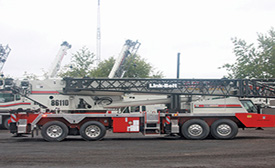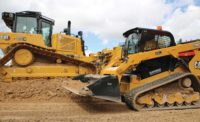Link-Belt showed off its new truck-mounted crane, the HTC-86110 (above), and the TCC-1400 telecrawler (below) at its annual exposition in Lexington, Ky., in October.
With an eye on growing demand for cranes that can reach even more extreme heights, Link-Belt this past month unveiled a bevy of new cranes, including a 140-ton-capacity telecrawler with a 195-ft boom and a 110-ton, truck-mounted crane with an unusual fly system.
The cranes were the centerpiece of the company's CraneFest open house at its Lexington, Ky., headquarters in October. Among the parade of cranes, the TCC-1400 stood out as Link-Belt's attempt to meet demand for high-capacity, long-boom lifts in the oil-and-gas market as well as massive infrastructure jobs.
"The TCC-1400 has a working radius of 185 feet with no fly, and fly packages are available," says Pat Collins, director of product marketing for Link-Belt. "We've got one of these 1400s up at the Indianapolis Motor Speedway, where it is performing long-range work as part of the upgrade for the 2016 season." When using the onboard, bi-fold lattice fly, the crane can extend to a maximum tip height of 259 ft.
Designed to work in areas with uneven ground pressure, the TCC-1400 can use its full lift chart on up to a 4° list. "Four degrees may not sound like a lot," says Collins, "but you take a look at the boom of a crane at 3°, and you realize what this level of stability means." A digital inclinometer in the cab shows the crane's list angle at all times, and the operator can program a virtual wall to limit the crane's swing radius.
"A real neat feature we have [on the TCC-1400] is a ground-bearing system," says Greg Martin, a design engineer for the TCC-1400. "What that means is that it doesn't measure the ground-bearing pressure directly, but it calculates it live." With the TCC-1400 targeted to oil-and-gas work that may be in rough jobsite conditions, maintaining stability on poor ground conditions is even more important.
"Generally, the jobsite conditions determine what the maximum ground-bearing pressures are that should be part of the lift plan," explains Martin. "You can set it up so it is constantly monitoring the ground-bearing pressure, but it's not actually a measurement. It's a calculation based on the geometry. You can set it so it gives you a warning if you exceed it."
While the far-reaching TCC-1400 was the largest machine launched by Link-Belt at Cranefest, the HTC-86110 truck-mounted crane drew the largest crowd. The crane's 164-ft, six-section greaseless boom comes with an onboard fly storage system, offering three stages of fly, reaching 10 ft, 58 ft and 262 ft.
A single worker with a cordless drill can deploy the fly jib. After loosening a few bolts, the fly can be swung out from its side-mounted location to the tip of the boom, a procedure that often requires hammering pins or turning on the truck's engine. After a worker swings the fly around by its guide strap, the bolts can be retightened to secure it.
"We were trying to get it so one person could just set up the fly and get going," says Kyle Pinsen, a Link-Belt design engineer for the HTC86100. "Not having to turn on the truck or get out special tools really can save set- up time."
"Our focus here was on ease and efficiency of storage: no more pounding pins or climbing up and down on the crane," adds Collins.





Post a comment to this article
Report Abusive Comment